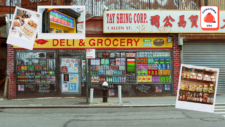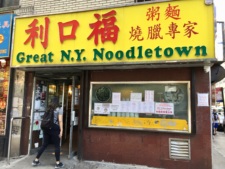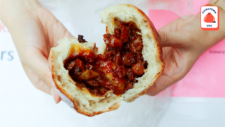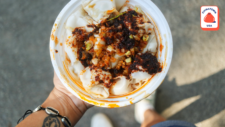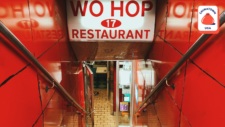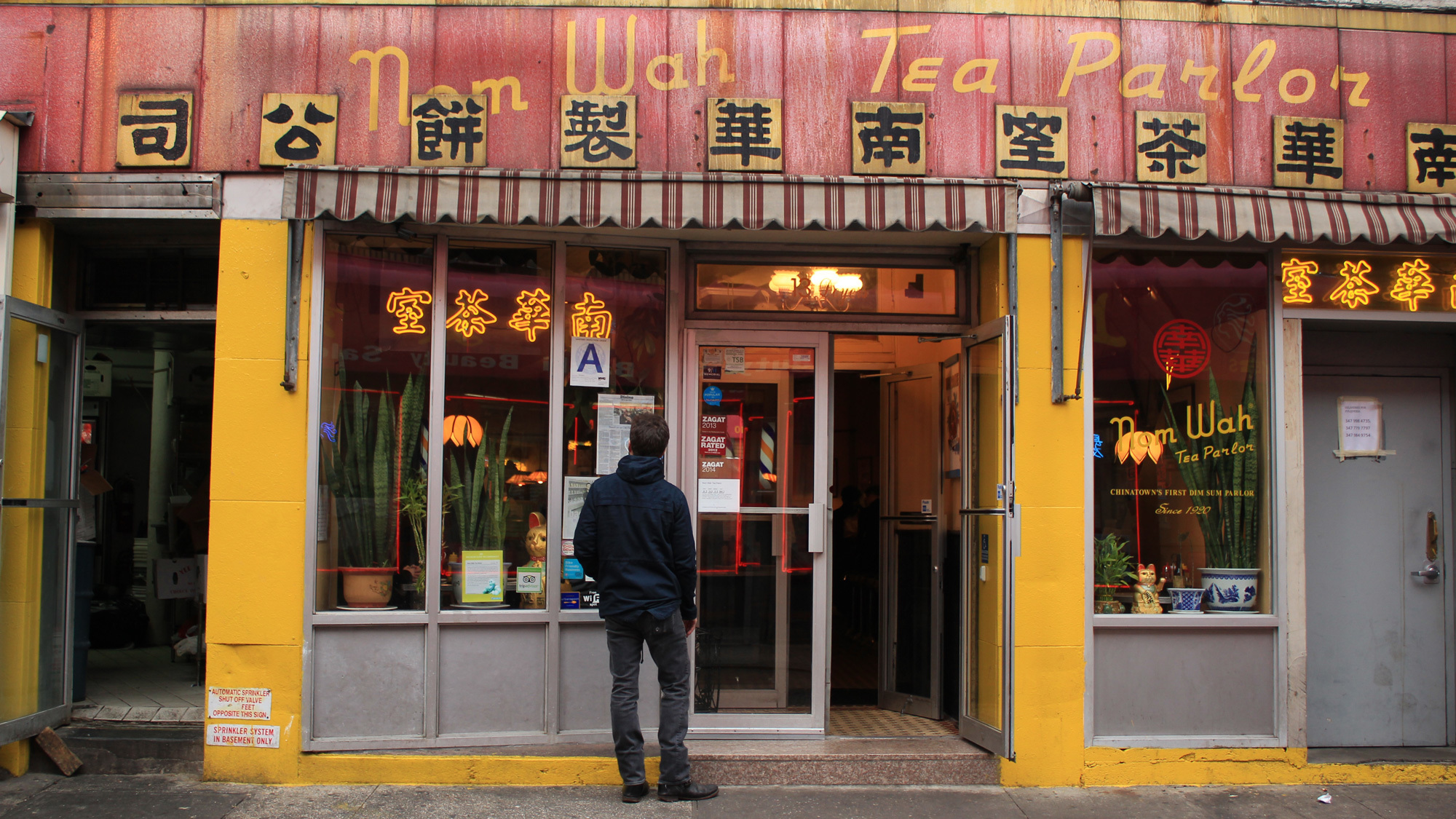
The Enduring Value of New York’s Oldest Chinese Restaurant
Nom Wah Tea Parlor, as my family tells it, was the first Chinese restaurant I ate at. I can’t confirm this, because I was, what, three years old? But a schlep to Nom Wah was a rite of passage for many uptown New Yorkers in the 1970s, especially Jews and especially the food-driven. And my father, while resistantly the former — he’d been kicked out of his yeshiva — was enthusiastically the latter. He’d not only studied cooking and restaurant management, he also was tutored, around the same time as Marcella Hazan, in Chinese cuisine by Grace Zia Chu, who’d introduced many Americans to it. Though his career meandered back toward Fortune 500 executive jobs, dumplings and pot au feu would hold an equally strong tug on his heart.
By this point, Nom Wah had been serving New Yorkers for more than 50 years. It was venerably known as the city’s first dim sum parlor, if no longer new and shiny, as it had been at its 1920 opening. But “dim sum” was still barely a known term to white New Yorkers at that point — indeed, Madame Chu, as she was known, drew attention for teaching students how to make what were sometimes dubbed “Chinese hors d’oeuvres.”
Nom Wah had evidently settled into a subdued routine by that point, offering tea with small plates of har gow, siu mai and the like; but yum cha, or what Americans were more likely to call tea service, was a source of growing fascination for those outside Chinatown. Uptowners would opine about the superior quality at newer arrivals, like Pot Luck Coffee Shop, just a few doors down the crooked arm of Doyers Street from Nom Wah.
In that era, though, a visit to Chinatown was often a journey. Developers wouldn’t start plying lower Manhattan for another decade or more, and the schism between uptown and downtown extended even to Chinese restaurants. In Midtown, and farther north, were a new and ambitious cohort, anchored by Shun Lee Dynasty, which Tsung Ting Wang opened in 1965, one of the early spots to debut after the belated end of the Chinese Exclusion Act the previous year. Shun Lee was pioneering, its Sichuan and Shanghaiese cuisine still rarities on these shores; both decor and plates were by the midcentury designer Russel Wright. This was important — a Western designer working for a Chinese owner.
Other, similar spots would proliferate Midtown, including the related Shun Lee Palace, and Uncle Peng’s Hunan Yuan, founded by Peng Chang-kuei, who in Taiwan had devised a dish dubbed General Tso’s chicken, and who wished to be early on the curve of Hunanese food in America. They were largely designed for a white American clientele: chopsticks a relative rarity, pointedly formal service, dishes more or less fiery depending who was at your table, blander staples like chow mein on offer. Old Chinatown, meanwhile, spoke to the past, to earlier generations of largely Cantonese-speaking immigrants. But among its loyal patrons were Jewish families from uptown, many of whose ancestors forged American roots just blocks away on the Lower East Side. My own father’s story only slightly diverged from this: Our family had escaped Germany in 1939, but settled up north — in Washington Heights. Still, it was a special treat to, say, go down to Hester St., and Guss’ Pickles, not even five minutes walk from Nom Wah.
By the early 1980s, New York had grown rougher edges. Manhattan’s Chinatown evolved — less Cantonese and more Mandarin. Successive waves of immigrants arrived from the mainland, many urbane and well educated, but with them came new members of criminal tongs, or gangs, whose influence weighed heavily on the neighborhood. Like other local restaurants, Nom Wah forged on, thanks in part to a loyal cadre of uptown regulars who continued to make the trek — including, say, the soprano Beverly Sills, who dutifully noted Nom Wah brunch as part of her Saturday routine. (“Brunch,” conceptually, was still taking hold; yum cha fit it well.)
At that point, we’d left for the suburbs, subject to the same willfully whitewashed Chinese food as most Americans: pupu platters, sticky-sweet pork, mai tais. Umbrellas on my Shirley Temples. If anything this seemed to amplify my father’s love — our mutual love, by that point — of Chinese cuisine. We would spend hours over the wok, at the stove, frying wontons. Was it anything but normal to have, say, fermented black bean sauce in the pantry, next to the alphabet soup? Not to us.
When I returned to the city in 1990, I recalled only the vague outlines of Nom Wah’s history. It had soldiered on, its old-time decor and mannerisms not yet nostalgic. Other, shinier spots had come along, like Golden Unicorn on East Broadway, with its 600 seats and tony modern Cantonese fare — its glitz touted by one critic as “a long way from Nom Wah Tea Parlor.” That year, Wally Tang, the uncle of current owner Wilson Tang, lamented to New York Magazine that his family had largely moved on to other pursuits, leaving behind the musty photographs and burnished diner stools.
“The new generation?” Tang said. “They do other things.”
I went downtown frequently, and certainly wandered past Nom Wah — who could resist a stroll down Doyers Street? And it’s likely I stopped in once or twice. But my interest in Chinese food lay elsewhere, mostly in the everyday knockoffs that proliferated from the previous era’s boomlet in Sichuan cuisine. There was hot and sour soup from Ollie’s, which I’d dose with as much chile oil as I could handle, a salve for winter colds. Or the ever expanding Empire Szechuan network, which like Starbucks was determined to appear on every block. Only later, when I moved to Queens, did I realize how much the city’s Chinese cuisines — especially in Flushing — had flourished. Stalwarts like Nom Wah were in the faint background.
▪️
My reunion with Nom Wah came relatively early on the curve of its renaissance: shortly after Wally retired and handed the reins to his young nephew, who reopened in early 2011. I was living in San Francisco then, but my memories of Nom Wah had marinated, drawing me back when I was in town. I noted Wilson’s subtle and deft transformation: dust gone from the memorabilia, but the old diner-style bones intact. Old egg rolls upgraded to a newer “original” model with an egg crepe wrapped in; classic har gow amended by a crystalline shrimp and pea-leaf dumpling; the old turnip cakes now cubed, and tricked out with XO sauce.
Wilson Tang’s story was too good not to be widely told: Having grown up in Queens, he ended up in finance but couldn’t resist his uncle’s request to continue the family tradition. So Nom Wah would blossom into the 21st century. This became obvious the first time I noticed the addition of a small wine list, and some very good Muscadet. For whatever reason — probably Twitter — he and I struck up an acquaintanceship, enough that I asked to throw my 40th birthday party there. (My father had died several years earlier, but would have appreciated the gesture.)
This brings us to a less-discussed side to Nom Wah’s rebirth: How Tang quietly drew the seeds of contemporaneity into New York’s oldest Chinatown. That has been a sometime complaint — who needs hipsters on Mott Street? — but it was also necessary for the neighborhood’s survival. People often overlook the restaurant Fung Tu, which Tang opened with business partner John Wells. Jonathan Wu, the chef, had cooked at Per Se and built his menu around his personal exploration of Chinese American food, like “Chinaquiles,” merging that breakfast staple with a form of mapo tofu, or an egg roll lush with pork belly. They hired a wine director, Jason Wagner, a rarity in Chinatown — so you could eat smoked mussels or shrimp chips with, say, a glass of heady palo cortado, or Olivier Horiot’s white Côteaux Champenois. My then-fiancée and I asked to throw our engagement party at Fung Tu. It was a mashup of all the things we loved.
Fung Tu was, alas, not long for this world, but I often believe its importance hasn’t been fully acknowledged. Chinese American chefs devising sui generis dishes — and others doing similar, like Danny Bowien, whose Mission Chinese opened not far from Fung Tu — have since proliferated, and thank goodness for it. But often these efforts are found far from Chinatowns. It was, in its way, one of the first to bring those uptown sensibilities downtown: to have, crucially, a good beverage program, which brings the extra money that so few Chinatown restaurants avail themselves of. This template has been embraced by others, like Nom Wah’s neighbor Chinese Tuxedo, or Pinch Chinese not far away in Soho — to say nothing of Asian-minded restaurants around the country. But to me, the link back to Nom Wah is particularly relevant. The past can indeed engender the future.
Nom Wah turns 100 this year, and what a bizarre and grueling year to celebrate that anniversary. But its resonance is stronger than ever; last year Wilson announced a branch had opened in Shenzhen, China. If the prospect of bringing New York-style dim sum, whatever that means, to southern China seems novel, that might be a symbol of the potency of Chinese American tradition at its best. Places like Nom Wah endure not because they capture a grainy black-and-white snapshot of Chinatowns past, but because they find a way to mesh that history with the present. And in doing so, they become a strong and sentimental part of our lives.
Discover More

Stephen Satterfield's Corner Table

